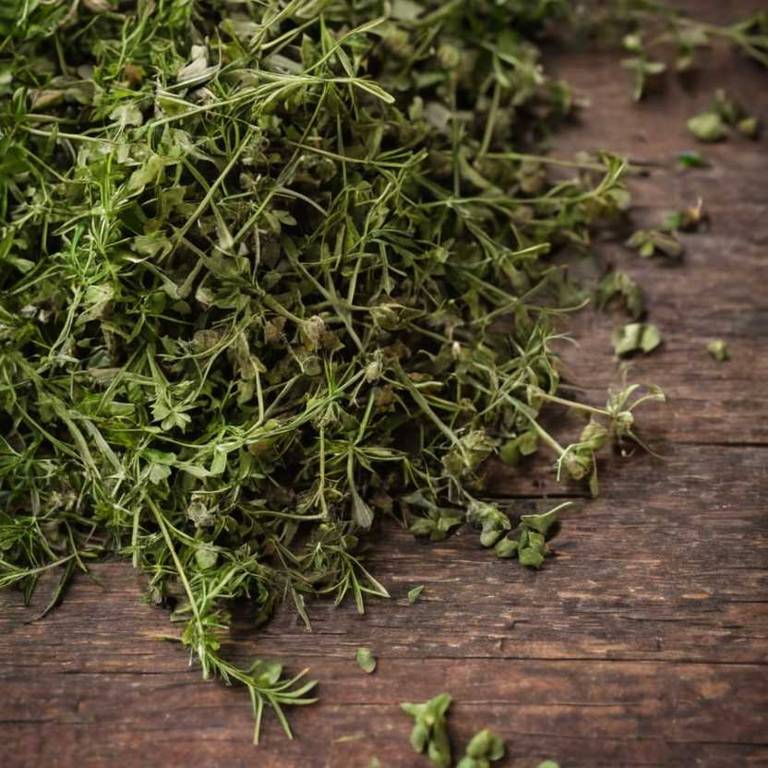Red Seaweed (Chondrus Crispus)
Information Reliability Score: 5/10
This score reflects the overall reliability of the information presented in this article. It is based on the quality of scientific evidence, accuracy of sources, and the transparency of references related to Chondrus crispus.
 Red Seaweed, scientifically known as Chondrus crispus, is a type of edible red algae commonly found along the coasts of the Atlantic Ocean. It is widely recognized for its medicinal properties and is often used as a natural source of nutrients and bioactive compounds. The primary benefits of red seaweed include its high content of iodine, antioxidants, and fiber, which support thyroid health, immune function, and digestive wellness. Traditionally, it has been used by indigenous communities and coastal cultures for food, dye, and even as a remedy for skin conditions and respiratory ailments. In modern wellness practices, red seaweed is incorporated into supplements, skincare products, and functional foods due to its unique compounds like fucoxanthin, which show potential in metabolic health and anti-inflammatory effects. Its distinctive red color and gelatinous texture, along with its historical significance in both culinary and medicinal traditions, make it a versatile and valuable resource in holistic health.
Red Seaweed, scientifically known as Chondrus crispus, is a type of edible red algae commonly found along the coasts of the Atlantic Ocean. It is widely recognized for its medicinal properties and is often used as a natural source of nutrients and bioactive compounds. The primary benefits of red seaweed include its high content of iodine, antioxidants, and fiber, which support thyroid health, immune function, and digestive wellness. Traditionally, it has been used by indigenous communities and coastal cultures for food, dye, and even as a remedy for skin conditions and respiratory ailments. In modern wellness practices, red seaweed is incorporated into supplements, skincare products, and functional foods due to its unique compounds like fucoxanthin, which show potential in metabolic health and anti-inflammatory effects. Its distinctive red color and gelatinous texture, along with its historical significance in both culinary and medicinal traditions, make it a versatile and valuable resource in holistic health.
FREE CHECKLIST
The Only 10 Herbs You Need to Heal 90% of Common Ailments.

Table of Contents
Scientific and Botanical Profile
Red Seaweed, with botanical name Chondrus crispus, is a species of red algae belonging to the family Rhodophyceae, commonly found in the Atlantic Ocean and surrounding regions such as North America, Europe, Northern Africa, the Iberian Peninsula, the British Isles, Scandinavia, Iceland, Greenland, and the Azores. Known by various common names including Coral Weed, Red Moss, Cornish Moss, Carrageen Moss, and Cornish Red, it is also referred to as Red Sea Fiddle, Crimson Sea Fur, Celtic Moss, and Red Irish Moss. Morphologically, Chondrus crispus is a perennial, calcareous seaweed that typically grows in dense, bushy tufts or fans, with a dark red to purple coloration and a leathery texture, often featuring a central stipe and branching fronds that curl and twist. This versatile and economically significant seaweed is widely used in food, pharmaceutical, and industrial applications due to its high carrageenan content, which provides thickening and gelling properties.History and Cultural Relevance
Red Seaweed was used by various ancient cultures, including the Celtic and indigenous peoples of the Atlantic coast, for both culinary and medicinal purposes. In traditional medicine systems, it was valued for its high mineral content, particularly iodine, and was used to treat thyroid disorders, skin conditions, and as a general tonic for health and vitality. In some coastal communities, red seaweed played a role in rituals and ceremonies, such as being used in offerings to the sea or incorporated into seasonal festivals that honored the ocean's bounty. Today, its traditional remedies, such as its use in wound healing and as a natural source of nutrients, are still recognized in modern herbal practices and dietary supplements. The plant continues to hold cultural significance as a symbol of resilience and connection to the natural world.Chemical Composition and Nutritional Profile
Red Seaweed contains a rich array of bioactive compounds, including polysaccharides such as agar and carrageenan, along with alkaloids, flavonoids, and various terpenes, which contribute to its medicinal properties. Nutritionally, it is a good source of vitamins like A, C, and K, as well as essential minerals such as iodine, calcium, magnesium, and iron, making it a nutrient-dense food. The antioxidants present in red seaweed help neutralize free radicals, reducing oxidative stress and supporting immune function. Its polysaccharides can bind to heavy metals and toxins, aiding in detoxification processes within the body. Additionally, the fiber content promotes digestive health, while the low-calorie profile makes it a beneficial addition to a balanced diet.Medicinal Properties and Health Benefits
Chondrus crispus has been recognized for its rich content of bioactive compounds, including carrageenan, minerals, and antioxidants, which contribute to its medicinal properties and health benefits. It supports the immune system by enhancing the body's defense mechanisms and reducing inflammation, making it beneficial for the respiratory and digestive systems. Additionally, it promotes cardiovascular health by helping to lower cholesterol levels and improve blood circulation. Compared to similar herbs like agar-agar or Irish moss, Chondrus crispus offers a higher concentration of minerals such as potassium and magnesium, providing greater potency in supporting electrolyte balance and muscle function. Its unique advantages lie in its ability to act as a natural thickener and emulsifier, making it not only a functional food but also a valuable supplement for overall wellness.Discover the 10 best health benefits of Red Seaweed.